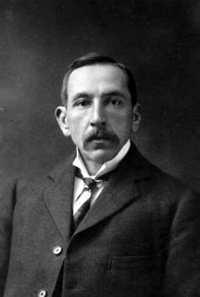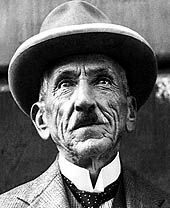Billy Hughes
|
|
William Morris "Billy" Hughes (September 25 1862 - October 28 1952), Australian politician, was the seventh Prime Minister of Australia, the longest-serving member of the Australian Parliament, and one of the most controversial figures in Australian political history. Over the course of his 51-year parliamentary career, Hughes represented four different electorates and was expelled from three different political parties.
Hughes was born in London of Welsh parents: his father was a carpenter at the House of Lords. Hughes was raised in Llandudno, Wales. When he was 14 he returned to London and worked as a pupil teacher. In 1884 he migrated to Australia, and worked as a labourer, bush worker and cook. He arrived in Sydney in 1886 and opened a bookshop. He joined the Socialist League and became a street-corner orator. In 1893 he became an organiser with the Australian Workers Union and joined the newly formed Labour Party.
Hughes was elected to the New South Wales Legislative Assembly as a Labour member in 1894. While in Parliament he became secretary of the Wharf Labourer's Union. In 1900 he founded and became first national president of the Waterside Workers' Union. During this period Hughes studied law, and was admitted as a barrister in 1903. Unlike most Labor men, he was a strong supporter of Federation.
In 1901 Hughes was elected to the first federal Parliament as Labor MP for West Sydney. He was Minister for External Affairs in Chris Watson's first Labor government. He was Attorney-General in Andrew Fisher's three Labor governments in 1908-09, 1910-13 and 1914-15. He was the real political brain of these governments, and it was clear that he wanted to be leader of the Labor Party. But his abrasive manner (his chronic dyspepsia was thought to contribute to his volatile temprament) made his colleagues reluctant to have him as Leader.
In October 1915 Fisher retired and Hughes succeeded him as Prime Minister. He was a strong supporter of Australia's participation in World War I, and after a visit to Britain in 1916 he became convinced that conscription was necessary if Australia was to sustain its contribution to the war effort. Most of his own party, and the trade unions, were bitterly opposed to this. In October Hughes held a referendum to try to gain approval for conscription, but the referendum, opposed by many of his colleagues, was defeated. This did not deter Hughes, who argued viciously and vigorously in favour of it, producing a deep and bitter split in his own party as well as in the Australian community In November 1916 he was expelled from the Labor Party.
Hughes and his followers formed a minority government, and he negotiated with the Liberal leader, Joseph Cook to form a new party, the Nationalist Party. In May 1917 the Nationalists won a huge electoral victory. At this election Hughes abandoned his working-class seat and was elected for Bendigo in Victoria. Hughes had promised to resign if his government did not win the power to conscript. A second referendum on conscription was held in December 1917, but was again defeated. Hughes, after receiving a vote of confidence in his leadership, resigned as Prime Minister, but as there were no alternative candidates Governor-General Sir Ronald Munro-Ferguson immediately re-commissioned him, thus allowing him to remain as Prime Minister while keeping his promise to resign.
(These were not referendums to alter the Australian Constitution. The government had the power under the Constitution to introduce conscription, as was done in World War II. But Hughes had given a pledge that he would not do so without the approval of the people, and he was unable to break that pledge despite pressure from his conservative colleagues and the British government to break his word.)
In 1919, Hughes and former Prime Minister Joseph Cook travelled to London to attend the Versailles peace conference. He remained away for 16 months, and signed the Treaty of Versailles on behalf of Australia - the first time Australia had signed an international treaty. At Versailles Hughes demanded heavy reparations from Germany and frequently clashed with President Woodrow Wilson of the United States. He succeeded in securing Australian control of Germany's colonial possessions in New Guinea. Despite the rejection of his conscription policy, Hughes retained his popularity, and in December 1919 his government was comfortably re-elected. At the Treaty negotiations, Hughes was the most prominent opponent of the inclusion of a racial equality clause, which as a result of lobbying by him and others was not included in the final Treaty. His position on this issue reflected a deep racism in early Australian politics and support for the White Australia Policy. Japan was notably offended by Hughes position on the issue.
After 1920 Hughes's political position declined. A new party, the Country Party, was formed, representing farmers who were discontented with the Nationalists' rural policies. Many conservatives opposed Hughes because they saw him as still a socialist at heart, despite his break with Labor. At the 1922 elections, Hughes switched from the rural seat of Bendigo to North Sydney, but the Country Party won enough seats in Parliament to be able to demand Hughes's resignation as their price for joining a Nationalist government.
Hughes resigned in February 1923, and was succeeded by his Treasurer, Stanley Bruce. Hughes was furious at this betrayal by his party and nursed his grievance on the back-benches until 1929, when he led a group of back-bench rebels who crossed the floor of the Parliament to bring down the Bruce government. Hughes was expelled from the Nationalist Party, and formed his own party, the Australian Party. In 1931 he buried the hatchet with his former colleagues and joined the new United Australia Party (UAP), under the leadership of Joseph Lyons.
In 1934 he became Minister for Health and Repatriation in the Lyons government. He was also Navy Minister, Industry Minister and Attorney-General at various times under Lyons and his successor, Robert Menzies, between 1934 and 1941. After the UAP nearly lost the 1940 federal election, Menzies was forced to resign by his colleagues, and in October 1941 Labor came to power under John Curtin. Menzies then resigned as UAP leader, and Hughes, aged 81 and very deaf, was elected party leader. He led the UAP into the 1943 election but was defeated, and resigned in favour of Menzies. In February 1944 the UAP withdrew its members from the Advisory War Council in protest against the Labor government of John Curtin. Hughes, however, rejoined the council, and for that he was expelled from the UAP.
In 1944 Menzies formed a new party, the Liberal Party, and Hughes became a member. His final change of seat was to the new electorate of Bradfield in 1949. He remained a member of Parliament until his death in October 1952. He had been a member of the House of Representatives for 51 years and seven months and including his service in the New South Wales colonial Parliament before that had spent a total of 58 years as a member of parliament. He was the last member of the original Australian Parliament elected in 1901 still in the Parliament when he died. He was not however, the last member of that first Parliament to die - that honour goes to King O'Malley who outlived him by fourteen months. His period of service remains a record in Australia. He was also the last Australian Prime Minister born in Britain.
Hughes' state funeral in Sydney was one of the largest Australia has seen: some 450,000 spectators lined the streets. Hughes, a tiny, wiry man with a wizened face and a raspy voice, was an unlikely national leader, but during the First World War he acquired a reputation as a war leader - the troops called him the "Little Digger" - that sustained him for the rest of his life. He is remembered for his outstanding political and diplomatic skills, for his many witty saying, and for his irrepressible optimism and patriotism. This admiration is not shared by the Labor Party, which still remembers him as a "rat."
See also
- First Hughes Ministry
- Second Hughes Ministry
- Third Hughes Ministry
- Fourth Hughes Ministry
- Fifth Hughes Ministry
| Preceded by: Isaac Isaacs | Attorney General of Australia 1908-1909 | Succeeded by: Patrick Glynn |
| Preceded by: Patrick Glynn | Attorney General of Australia 1913-1914 | Succeeded by: William Irvine |
| Preceded by: Gregor McGregor | Deputy Leader of the Australian Labor Party 1914–1915 | Succeeded by: George Pearce |
| Preceded by: Andrew Fisher | Leader of the Australian Labor Party 1915–1916 | Succeeded by: Frank Tudor |
| Preceded by: Andrew Fisher | Prime Minister of Australia 1915–1923 | Succeeded by: Stanley Bruce |
| Preceded by: (none) | Leader of the National Labor Party 1916–1917 | Succeeded by: (none) |
| Preceded by: (none) | Leader of the Nationalist Party of Australia 1917–1923 | Succeeded by: Stanley Bruce |
| Preceded by: (none) | Leader of the Australian Party 1930–1931 | Succeeded by: (none) |
| Preceded by: (none) | Longest serving member of the Australian House of Representatives 1935–1952 | Succeeded by: Earle Page |
| Preceded by: Robert Menzies | Leader of the United Australia Party 1941–1943 | Succeeded by: Robert Menzies Sources
External links
|


